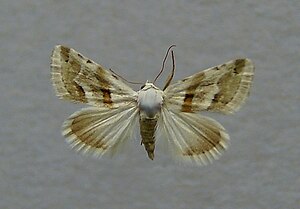Strawberry Owl
| Strawberry Owl | ||||||||||||
|---|---|---|---|---|---|---|---|---|---|---|---|---|

Eublemma minutatum |
||||||||||||
| Systematics | ||||||||||||
|
||||||||||||
| Scientific name | ||||||||||||
| Eublemma minutatum | ||||||||||||
| ( Fabricius , 1794) |
The sand straw flower owl ( Eublemma minutatum , incorrectly also Eublemma minutata ) or dwarf owl is a butterfly ( moth ) from the family of owl butterflies (Noctuidae).
features
butterfly
The wingspan of the moth is only 13 to 15 millimeters. This makes them one of the smallest owl butterflies. The fore wings are whitish in the root field and are sharply delimited by a red-brown band beginning at the inner edge. This is followed by a light field with brownish shadows. The fringing area has a brownish dusting and shows a distinct dark spot at the apex . Pine cone, ring and kidney defects are not visible. In some areas, the moths have a slightly darker basic color. The hind wings are whitish in the root field and merge into a light brown tint towards the edge field. The outer edge is made up of fine white hairs.
Egg, caterpillar, pupa
The egg is tiny and sand-colored. The young caterpillar is gray in color and has short hairs, later it is greenish, has indistinct white back and side back lines as well as black points and hardly stands out from the forage plant. The head is very small and black. The brown-yellow doll has a compact shape.
Geographical distribution and habitat
In Europe, the northern limit of distribution runs from southern England , south- eastern Belgium and northern Germany via central and eastern Denmark , southern Scandinavia to Estonia and St. Petersburg . In the south, the occurrence includes northern Spain , Corsica , northern Italy , the Croatian Adriatic coast , Albania and Lebanon . The occurrence of the species is linked to the presence of the forage plant, which is why it occurs only very locally in the area surrounded by the aforementioned regions - but in some cases in large numbers. The main habitats are sandy heather, inland dunes, dry pine forest edges and warm wasteland.
Way of life
The moths are diurnal and nocturnal and fly in July and August. During the day you occasionally visit the flowers of the sand straw flower ( Helichrysum arenarium ) or fly short distances in the sunshine. At night they appear on artificial light sources , occasionally also on bait . The resting position of the moths on flowers or stems, always pointing downwards, is characteristic. The caterpillars live on the straw flower from May to June and feed primarily on its flowers, shoot tips and fruit heads. They like to hide in a whitish web below the flower head.
Danger
The occurrence of the strawberry owl in Germany is strongly endangered because of the strong connection to the forage plant wherever this is also in decline. On the Red List of Threatened Species , it is classified in Category 2 (critically endangered).
swell
Individual evidence
- ↑ Walter Forster , Theodor A. Wohlfahrt : The butterflies of Central Europe. Volume 4: Owls. (Noctuidae). Franckh'sche Verlagshandlung, Stuttgart 1971, ISBN 3-440-03752-5 .
- ↑ Arno Bergmann: The large butterflies of Central Germany. Volume 4/2: Owls. Distribution, forms and communities. Urania-Verlag, Jena 1954, DNB 450378381 .
- ^ Günter Ebert: The Butterflies of Baden-Württemberg Volume 5, Moths III. Ulmer Verlag, Stuttgart 1997, ISBN 3-800-13481-0
- ↑ Federal Agency for Nature Conservation (Ed.): Red List of Endangered Animals in Germany. Landwirtschaftsverlag, Münster 1998, ISBN 3-89624-110-9
literature
- Günter Ebert: The Butterflies of Baden-Württemberg Volume 5, Moth III. Ulmer Verlag, Stuttgart 1997, ISBN 3-800-13481-0
annotation
- ↑ The gender of the genus Eublemma is neuter, from τό βλέμμα, -ατος = look, face, eye. The gender of the species name must be adjusted accordingly
Web links
- www.lepiforum.de - Taxonomy and photos
- www.nic.funet.fi - endangerment
- Eublemma minutata in Fauna Europaea. Retrieved November 6, 2012